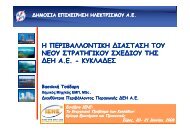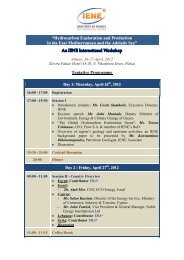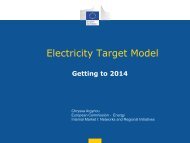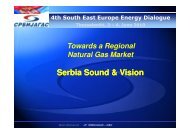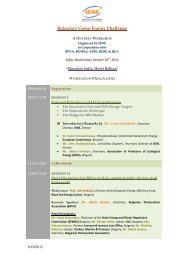Prof. Pantelis Kapros
Prof. Pantelis Kapros
Prof. Pantelis Kapros
- No tags were found...
You also want an ePaper? Increase the reach of your titles
YUMPU automatically turns print PDFs into web optimized ePapers that Google loves.
<strong>Prof</strong>. <strong>Pantelis</strong> CAPROS, E3MLab/NTUAPRIMES ModelUpdate February 2011
PRIMES-based Outlook Comprehensive energy-economy-emissions scenarios forall countries of the South East Europe The projections concern all demand sectors, powergeneration, energy supply and trade and energy prices Various scenarios explore uncertainties about Future policies and targets for Renewables Measures promoting energy efficiency Constraints and ETS for emissions of CO2 Projections are available until 2030, by 5-year steps Data updated reflecting the crisis and beginning ofrecoveryE3MLab/NTUA - www.e3mlab.ntua.gr2
Long termProjection ofeconomic growthThe SEE region experienced higheconomic growth in the firstdecade of the 21 st centurySlowdown and depression trendscaused by the global crisis will bereversed starting from 2011-12The projection shows growth ratesbetween 4.5 and 5% per yearduring the recovery period 2012-2020, except for GreeceA slowdown of the growth pace isprojected for the period 2020 to2030. The reasons are:• Poor demographic developments insome countries, mainly in countriesmembers of the EU• Fierce global competition fromemerging economies• Long-term growth of the EU notexceeding 2% per year%10,008,006,004,002,000,00-2,00-4,00-6,00100%75%50%25%0%199119931995Real GDP growth of the SEE region(% change from a year earlier)199719992001200320052007200920112013Shares in Real GDP201510 11 11 1026 25 21 2051 52 54 572000 2010 2020 203020172019202120232025AlbaniaFYROMBosniaSerbiaCroatiaBulgariaRomaniaGreeceTurkey20272029E3MLab/NTUA - www.e3mlab.ntua.gr3
The Reference Scenario• The Reference scenario analyses the impacts from fullimplementation of the EU legislative package for ETS,renewables and energy efficiency.• The scenario assumes that this legislation (both RES andETS) do not apply to the non EU countries of the SEE• As strong parallel policies develop, the EU-ETS carbonprices stay at lower levels than in Baseline, namely at 17EUR’08/tCO2 in 2020 and 36 EUR’08/tCO2 in 2030• Two alternative Reference scenarios explore• What if Renewables policies also apply to non EU countries• What if also EU ETS applies to the non EU countries of SEEE3MLab/NTUA - www.e3mlab.ntua.gr4
Implications on CO2 EmissionsCO2 Emissions from Energy in Mt1312111098765Albania20191817161514131211Bosnia272523211917Croatia85807570656055Serbia272523211917Croatia42005 2010 2015 2020 2025 2030102005 2010 2015 2020 2025 2030152005 2010 2015 2020 2025 2030502005 2010 2015 2020 2025 2030152005 2010 2015 2020 2025 2030Baseline Reference Reference with RES Reference with RES and ETS100959085Greece5048464442Bulgaria959085Romania450400350Turkey800750700SEE8040650757065383634328075300250600550602005 2010 2015 2020 2025 2030302005 2010 2015 2020 2025 2030702005 2010 2015 2020 2025 20302002005 2010 2015 2020 2025 20305002005 2010 2015 2020 2025 2030E3MLab/NTUA - www.e3mlab.ntua.gr5
Implications on CO2 EmissionsThe policies involved in the Reference scenario variants succeedcurbing CO2 emissions in the SEE region; the reduction from Baselineranges between 3 and 10% in 2020 and between 6 and 19% in 2030.Applying the EU RES policies in all SEE countries imply emissionreduction of 7% in 2020 and 10% in 2030; applying in addition the EUETS delivers more reduction: 10% from baseline in 2020 and 19% in2030.The Reference scenario which applies the EU 20-20-20 policies only onthe EU members of the SEE has smaller impacts on emissions in theSEE taken as a whole; although not applying additional policies in thenon EU countries, the Reference scenario shows some emissionreduction in these countries as well.It is worth noting that even the Reference scenario with RES and ETSdoes not succeed to reduce emissions from 2005 levels in the SEEregion, the results showing that emissions still increase by 10% in 2020relative to 2005 and remain at that higher level until 2030.E3MLab/NTUA - www.e3mlab.ntua.gr6
Impacts on the SEERES as % of Gross Demand is 15% inReference and increases to 18-19% ifRES and ETS policies were applied toall SEE countries. Untappedpossibilities exist for wind, solar,hydro and biofuels with incrementalinvestment amounts of 30 billionEUR’08 in the period 2011-2030Average SEE Electricity pricesincrease only after 2020 andespecially for households and tertiary,the industrial prices being lessinfluenced.The participation of the entire SEEregion in the EU ETS has dramaticeffects on solid fuels generation, withgas-based generation reducing much.The auction payments for the carbonallowances drive electricity pricesupwards: 7% up in 2020 and 14% upin 2030 from Baseline levels.The Reference with RES and ETSscenario requires 63 billion EUR’08more than in Baseline for the period2011-2030 for energy investment.SEEBaseline Reference Ref. with RES Ref. RES and ETS2020 2030 2020 2030 2020 2030 2020 2030% changes from BaselineCO2 Emissions (Mt CO2) 706.3 758.3 -3.1 -5.7 -6.9 -10.1 -9.8 -19.3Total primary energy (ktoe) 280,865 320,952 -1.3 -3.0 -2.5 -5.0 -4.0 -6.7Total final energy (ktoe) 198,506 231,681 -1.1 -3.0 -0.9 -2.7 -1.5 -3.5Final Electricity Demand (GWh) 481,987 606,220 -0.6 -0.2 -6.1 -6.4 -8.3 -8.9Total demand for Solids (ktoe) 69,536 65,904 -2.5 -9.3 -7.0 -15.5 -15.1 -33.3Total demand for Oil (ktoe) 91,461 100,863 -2.2 -2.9 -2.6 -3.4 -2.9 -4.6Total demand for Gas (ktoe) 80,249 99,648 -4.6 -5.1 -11.7 -12.1 -9.6 -10.3Total Renewables (ktoe) 29,475 33,579 12.4 13.1 31.9 39.7 32.5 42.0Total Nuclear Fuel (ktoe) 9,801 20,508 0.0 0.0 0.0 -18.0 0.0 5.5(values)RES as % Gross Demand 13.6 12.9 15.4 14.8 18.2 18.6 18.5 19.0Net Imports of Electricity (GWh) 3,992 5,237 3,992 5,237 3,992 5,237 3,992 5,237Structure of Power generation%% %%Nuclear 6.6 11.6 6.7 11.7 7.1 10.1 7.3 13.5Solids 31.8 26.7 31.0 23.5 30.9 22.5 28.0 16.6Gas 34.0 35.1 32.6 35.4 29.1 31.6 31.1 32.8Oil 1.4 0.7 1.4 0.7 1.4 0.7 1.4 0.7Hydro 20.1 17.6 20.2 17.6 21.5 18.8 22.0 19.4Wind 4.2 5.2 5.8 7.2 6.7 8.5 6.9 8.9Biomass 0.9 1.4 1.3 2.1 2.2 3.6 2.2 3.8Solar etc. 0.9 1.8 1.0 1.8 1.2 4.1 1.2 4.3Carbon intensity (tCO2/MWh) 0.42 0.35 0.41 0.32 0.39 0.30 0.37 0.22Pre-tax Electricity Prices (€'08/MWh)(values)Average 99.7 104.2 98.4 103.7 99.6 108.1 107.1 119.8Energy intensive industries 74.4 73.9 71.9 72.4 70.8 71.8 78.3 80.2Other industries 95.9 98.7 94.5 98.0 95.5 101.7 104.5 113.7Households 104.0 112.1 103.1 112.0 106.1 118.2 113.5 131.7Services 114.0 115.0 113.3 114.1 117.3 122.0 125.2 134.8Cost of Power Supply (€'08/MWh)(values)Generation 80.7 80.3 79.1 79.4 80.2 82.7 86.6 92.4Capital 37.2 39.0 38.3 40.3 40.4 44.8 41.2 48.0Variable 39.1 36.4 38.2 36.1 37.1 34.7 37.3 34.4Fuel Taxes and Auction payments 4.3 4.8 2.6 3.1 2.7 3.2 8.1 10.1Grid 19.7 24.6 19.9 25.0 20.1 26.0 21.1 28.1Total Cost of Energy in billion €'05 255.6 364.3 256.9 368.0 255.6 368.5 259.2 376.811-20 21-30 11-20 21-30 11-20 21-30 11-20 21-30Total Energy Investment (billion €'08) 350.3 369.2 361.3 387.9 349.4 400.5 350.6 432.5Differences from Reference 10.9 18.8 -0.9 31.4 0.3 63.3E3MLab/NTUA - www.e3mlab.ntua.gr7
Impact of HighCarbon PricesIt is assumed that the entire SEE regionjoins the EU ETS mechanism, whichinvolve full auctioning of emissionallowances from 2013 onwards.The carbon prices influence the mix oftechnologies and fuels in powergeneration inducing more developmentof carbon free generation, such asnuclear, renewables and CCS (which hasnear zero but not zero emissions).Obviously carbon prices are detrimentalfor conventional generation based onfossil fuels, however usually gas-basedgeneration may be favoured in somecircumstances as gas emits less thancoal.As emission allowances involvepayments in the auctions, the carbonprices increase the variable costs offorms of generation that emit CO2; tothe extent these forms of generationparticipate in the determination ofmarginal costs of electricity, auctionpayments induce higher costs hencehigher electricity prices. Higher cost ofenergy for consumers further inducelower demand for energy.90.080.070.060.050.040.030.020.010.00.0% Change of Avg. ElectricityPrice from BaselineCarbon prices in EUR'2008/tCO22000 2005 2010 2015 2020 2025 2030302520151050SEE0 10 20 30 40 50 60 70 80 90ETS Carbon Price (€'08/ t of CO2)ETS at 17€/tCO2 in2020ETS at 25€/tCO2 in2020ETS at 38€/tCO2 in2020ETS at17€/tCO2in 2020ETS at25€/tCO2in 2020ETS at38€/tCO2in 2020E3MLab/NTUA - www.e3mlab.ntua.gr8
Impact of High Carbon PricesThe participation of all the SEE countries in the ETS market with fullauctioning of emission allowances will imply considerable changes in thestructure of power generation and will have strong impacts on costs andprices.Power will be generated by using more nuclear (10 to 14% more, 12 GW in themaximum case), significantly more renewables (20 to 25% more than inBaseline), less solid fuels (30 to 37% less than in Baseline) and slightly less gas.CCS plants will be commissioned mainly after 2025 with capacities rangingfrom 6 to 17.5 GW depending on the level of the carbon prices; in the highestcarbon price case CCS represents 24% of total power generation capturing 16%of total emissions from the SEE energy system.For carbon prices above 30 EUR/tCO2 solid fuel generation without CCS is noteconomic; in general, gas-based generation becomes the marginal fuel in pricesetting in all carbon pricing scenarios.The RES% share attains 16% in all carbon price scenarios. Wind power reaches27 GW in 2030 for the highest carbon price case (17 GW in Baseline), solar PVbeing 16 GW (7 GW in Baseline with biomass capacities at 3.3 GW (1.4 GW inBaseline).E3MLab/NTUA - www.e3mlab.ntua.gr9
Impact of High Carbon PricesCarbon intensity of power generation in 2030 is 60% lower than in Baseline inthis high carbon price case and total CO2 emissions reduce by 27% frombaseline level in 2030.Electricity prices increase between 10 and 18% in 2020 from Baseline levels andbetween 18 and 25% in 2030. In the highest carbon price case, electricity pricesin 2030 are found 50% higher than present levels. The impacts on prices forenergy intensive industries are smaller than for households and servicessectors. The grid tariffs are likely to increase between 5 and 10% from Baselinelevels. Incremental investment needs are 16 billion EUR’08 for the highestcarbon price case in the period 2011-2030, which is 20% above Baseline levels.Total cost of energy in the highest carbon price case in incremental terms fromBaseline is between 0.4 and 0.6% of SEE GDP in real terms.The SEE countries that are members of the EU bear small impacts fromescalating carbon prices, relative to the Baseline; the cost structure mainlychanges reducing auction payments and increasing costs of developing carbonfree sources.The non EU SEE countries incur high additional costs from raising carbonpricing with Bosnia, FYROM and Serbia being more vulnerable than Croatia,Albania and Turkey.E3MLab/NTUA - www.e3mlab.ntua.gr10
Impact of High ETSPricesAs expected carbon prices inducelower CO2 emissions. The rates ofdecrease differ by country dependingon possibilities and the economics ofdeveloping against the potential ofcarbon free resources. The degree ofexploitation of the carbon freepotential in the beginning of thesimulation also influences the size ofeffects from carbon prices, as forexample for countries that havealready today achieved low carbonintensity.For example Bulgaria and Romaniashow lower response rates to carbonprices because they have developedsignificant carbon free resources inthe business as usual trends;contrasted examples are those ofSerbia, Bosnia and Greece which showhigher response rates to carbon pricesalso because they have a carbonintensive energy system at present.Generally the range of emissionreductions in 2030 between theBaseline and the highest carbon pricecase examined is between 20 and 45%for the year 2030.ETS at 17€/tCO2 in ETS at 25€/tCO2 in ETS at 38€/tCO2 inSEEBaseline2020202020202020 2030 2020 2030 2020 2030 2020 2030% changes from BaselineCO2 Emissions (Mt CO2) 706.3 758.3 -5.5 -16.3 -8.6 -24.1 -10.5 -27.4Total primary energy (ktoe) 280,865 320,952 -2.7 -5.7 -4.1 -6.1 -5.2 -6.2Total final energy (ktoe) 198,506 231,681 -1.7 -3.9 -1.9 -4.1 -2.3 -4.6Final Electricity Demand (GWh) 481,987 606,220 -2.9 -3.4 -4.2 -4.5 -6.0 -5.8Total demand for Solids (ktoe) 69,536 65,904 -8.7 -26.7 -17.9 -30.1 -23.1 -31.4Total demand for Oil (ktoe) 91,461 100,863 -2.3 -3.7 -2.3 -3.8 -2.4 -4.2Total demand for Gas (ktoe) 80,249 99,648 -4.0 -4.1 -1.9 -5.6 -0.8 -6.4Total Renewables (ktoe) 29,475 33,579 13.0 17.5 15.3 22.4 14.6 24.2Total Nuclear Fuel (ktoe) 9,801 20,508 0.0 5.5 0.0 9.7 1.4 15.1(values)RES as % Gross Demand 13.6 12.9 15.6 15.6 16.0 16.2 16.0 16.5Net Imports of Electricity (GWh) 3,992 5,237 3,992 5,237 3,992 5,237 3,992 5,237Structure of Power generation%% %%Nuclear 6.6 11.6 6.8 12.8 6.9 13.4 7.2 14.3Solids 31.8 26.7 29.1 18.6 25.3 17.5 23.7 17.8Gas 34.0 35.1 33.5 36.4 35.7 34.7 37.1 33.0Oil 1.4 0.7 1.4 0.7 1.4 0.7 1.4 0.7Hydro 20.1 17.6 20.7 18.2 21.7 19.0 21.5 18.8Wind 4.2 5.2 6.1 8.0 6.6 8.5 6.8 8.7Biomass 0.9 1.4 1.3 2.1 1.4 2.2 1.4 2.6Solar etc. 0.9 1.8 1.0 3.2 1.0 3.9 1.0 4.0Carbon intensity (tCO2/MWh) 0.42 0.35 0.39 0.24 0.36 0.16 0.35 0.14Pre-tax Electricity Prices (€'08/MWh)(values)Average 99.7 104.2 105.9 117.9 110.5 122.8 118.0 130.1Energy intensive industries 74.4 73.9 79.4 81.3 83.2 82.8 88.1 86.6Other industries 95.9 98.7 102.2 111.7 107.3 116.8 115.5 125.3Households 104.0 112.1 110.9 128.1 115.8 134.0 124.2 142.2Services 114.0 115.0 121.6 130.6 126.9 136.9 135.4 145.2Cost of Power Supply (€'08/MWh)(values)Generation 80.7 80.3 85.5 91.1 89.6 95.0 96.3 101.2Capital 37.2 39.0 39.0 45.2 40.0 48.6 40.8 50.7Variable 39.1 36.4 38.0 35.2 37.7 35.1 38.0 35.8Fuel Taxes and Auction payments 4.3 4.8 8.5 10.6 11.9 11.3 17.5 14.6Grid 19.7 24.6 21.0 27.5 21.6 28.5 22.4 29.6Total Cost of Energy in billion €'05 255.6 364.3 260.7 378.2 262.8 381.5 266.6 387.311-20 21-30 11-20 21-30 11-20 21-30 11-20 21-30Total Energy Investment (billion €'08) 350.3 369.2 362.9 436.8 367.6 466.5 371.2 484.1Differences from Reference 12.6 67.6 17.3 97.3 20.9 115.0E3MLab/NTUA - www.e3mlab.ntua.gr11
Concluding RemarksThe SEE region is projected to grow less than expected some years before the recenteconomic crisis. This implies less energy demand growth than expected. Hence, newinfrastructure projects and new investments need to downsize relative to older plans.Gasification trends anticipated in the past are still valid in the new conditions, as gascomplies with new growing environmental concerns. Incremental gas requirements willbe lower in the future than expected. The gasification in power generation in the longterm remains a dominant trend but the volumes are limited because of expectationsabout new investment in nuclear, renewables and CCS depending on the policyconstraints that will prevail in the future. If decarbonisation and RES policies arepursued more intensively gas requirements will not necessarily increase from Baselinelevels, as other options will develop faster. Nevertheless, gas generation capacities willremain important and has to develop in order to support intermittency of renewablesand dispatching flexibility.Oil will remain an important constituent in the fuel mix but its role will decline insubstitutable uses remaining however dominant in specific uses, such as intransportation. Possible change of energy carrier in this sector, for example throughelectro-mobility, will have strong effects on demand for oil.Solid fuels constitute an important indigenous energy source of the SEE countries buttheir future use in power generation is very sensitive on carbon prices and other policiessuch as for the RES. Maintaining use of solid fuels in power generation at business asusual levels will depend on the development of CCS in the long term. CO2 storagepossibilities exist in some Balkan countries.E3MLab/NTUA - www.e3mlab.ntua.gr12
Concluding RemarksNuclear energy is shown to develop up to maximum possibilities in three of the SEEcountries. The results show inflexibility for further expansion of nuclear energy.Renewables have a great untapped potential in the SEE region. Wind power is likely tobecome the fastest expanding source of generation, but the wind potential is ratherlimited in the central and west Balkan countries. Solar PV has also a great potentialespecially in the southern countries of the region. The volume of unexploited biomassresources is remarkably high in most of the SEE countries.Developing the RES in power generation will require higher capital investment and willbe possible only if specific RES supporting policies are in place, such as the feed-intariffs with attractive price levels. The development of RES will also require investmentin the grids and the presence of sufficient ancillary and back-up services. They will bothimply higher generation and electricity supply costs, but the development of RESreduces other cost components especially the auction payments if carbon pricing in EUETS is generally applied in the region.Electricity prices are projected to increase significantly in the future relative to presentlevels. A major reason is the pricing below total true costs that has been practiced in thepast in most of the SEE countries. The increasing role of gas will also have implicationson prices as in the wholesale markets gas will be increasingly be the marginal fuel inprice setting, especially in load following. The grid costs components will also increasesubstantially. The prices for energy intensive industries are expected to increase muchless than the prices for households (generally cross-subsidised) and for services sectors.E3MLab/NTUA - www.e3mlab.ntua.gr13
Concluding RemarksThe generalisation of strong RES policies in the rest of the SEE countries is possible andinitiatives are on going for this purpose. The RES can develop substantially and will havesome moderate impacts in electricity costs and prices.The participation of all the SEE countries in the EU ETS is not currently in the policyagenda but there are chances to emerge in the future within the process of concertedactions towards decarbonisation and in the negotiation of agreements with theEuropean Union.The generalisation of the EU ETS with full auctioning of allowances will driveconsiderable change in power generation: it will put solid fuel projects at risk but willfavour CCS in the long term; it will provide a strong push to RES but less to nuclear; itwill sustain gasification trends. The most important effect will be on electricity prices,because the price of allowances will influence marginal costs at various load levels andwill be passed through to consumer prices.The simulations shows that prices in some of the SEE countries, such as Serbia(grouping also Montenegro and Kosovo), Bosnia, FYROM and Turkey, are likely toincrease between 25 and 50% from Baseline levels depending on the level of the EU ETScarbon prices in the future. The electricity prices in Greece are also likely to increaseconsiderably from past levels but this increase is projected to take place also under theBaseline conditions. The rest of the SEE countries are less vulnerable to carbon pricing.In the context of carbon pricing the increasing penetration of renewables do not add ontotal costs and prices but imply a shift in cost components from auction payments tocapital and grid costs.E3MLab/NTUA - www.e3mlab.ntua.gr14



